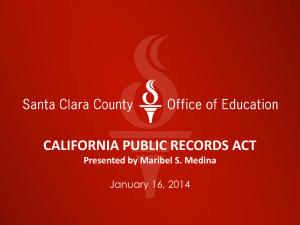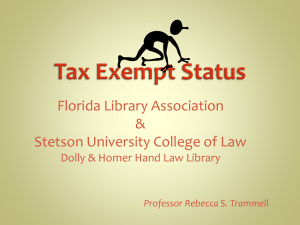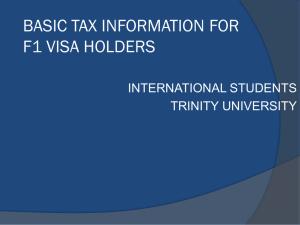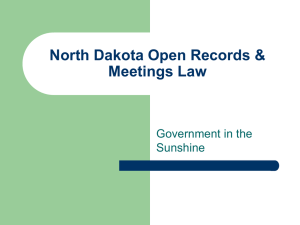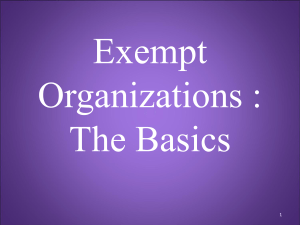Non-Profit Formation
advertisement
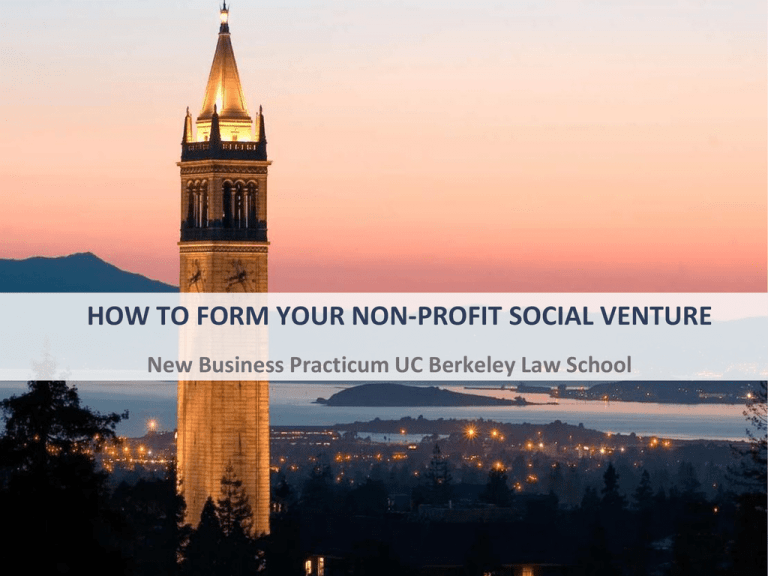
HOW TO FORM YOUR NON-PROFIT SOCIAL VENTURE New Business Practicum UC Berkeley Law School Today’s Presentation I. Rules of the Game for Tax Exempt NonProfits II. Getting Into the Game: How to Obtain Tax Exempt Status III. Playing Well with Others: Collaborating with Other Non-Profits and For-Profits Reminder This workshop is intended to provide you with general legal information, but it does not substitute for legal advice from an attorney! HOW TO FORM YOUR NON-PROFIT SOCIAL VENTURE I. Rules of the Game for Tax-Exempt Non-Profit Myths about Tax Exempt Non-Profits ❖ To get the benefit of tax exempt status, you have to apply to the IRS (?) ❖ For organizations that have tax exempt status: ❖ Can’t make a profit (?) ❖ Can’t engage in political activity (?) ❖ Never have to pay taxes (?) ❖ Always possible for donors to get tax deductions (?) ❖ Have to pay small salaries (?) Sum: Why Apply for Tax Exempt Status for Your Organization? Advantages – investment income, except: • income from activities unrelated to tax exempt purposes • investment income from assets acquired with debt – Tax Deductions for Charitable Contributions – Can utilize volunteers – Exemption from other Taxes: Disadvantages • Activities must be limited to 501c3 exempt purposes • No substantial Lobbying • No political activity on behalf/in opposition to any candidate • Upon dissolution, assets must be donated to another 501c3 • Cannot unduly benefit private individuals • Federal Unemployment Tax • Greater scrutiny by IRS and State Attorney General’s Office • State Property/Franchise Taxes • Limited Resources (typically) What’s Different about Being Tax Exempt? A non-profit is essentially a trust – A custodian of assets that have been dedicated to the public good. Guiding Principles (4) 1) Organized and operated exclusively for exempt purposes 2) No private benefit (e.g., no profit sharing) 3) Assets are permanently dedicated to exempt purposes 4) No advocacy for/against a candidate or legislation 1) Organized and Operated for Exempt Purposes ❖ IRS will only grant tax exempt status to organizations that are both organized and operated exclusively for one or more charitable, educational or other exempt purposes >> see IRS Code, 26 USC section 501(c)(3) ❖ • Organization’s bylaws, articles of incorporation, and Board of Directors Meetings A Non-Profit Organization risks losing its tax exemption if it engages in activities unrelated to its exempt purpose -- Unless the activities are insubstantial in amount Exempt Purposes – 26 USC 501(c)(3) Includes: ❖ Relief of the poor and distressed or the underprivileged; ❖ Advancement of religion; ❖ Advancement of education, arts, culture or science; ❖ Promotion of amateur sports competition; ❖ Prevention of cruelty to children or animals; ❖ Promotion of social welfare by organizations designed to accomplish any of the above purposes, or ❖ (i) to lessen neighborhood tensions; ❖ (ii) to eliminate prejudice and discrimination; ❖ (iii) to defend human and civil rights secured by law; or ❖ (iv) to combat community deterioration and juvenile delinquency. See 26 CFR sec 1.501(c)(3)-1(d)(iv)(2) Is the Activity Related or Substantial? What is unrelated ? Activity that is not exempt (not 501(c)(3) purpose) Activity that does not further the exempt purposes stated in the non-profit’s articles of incorporation or its tax exempt application What is insubstantial? No set test IRS Rulings: figure <15% of organization resources What if the Activity is Unrelated ? ❖ Again, the organization may engage in the activity, without jeopardizing its tax exemption, as long as the activity is not more than an insubstantial part of the organization’s overall activities ❖ The organization may have to pay unrelated business income tax (UBIT) on profits from the activities ❖ The organization may want to consider establishing a subsidiary corporation for the unrelated activities (see later) 2) No Private Benefit >> Basic Rules ❖ No profit sharing ❖ No special perks for Board Members or Staff ❖ Private benefit can only be INCIDENTAL to accomplishing the exempt purpose -- e.g., non profit hospitals, Oregon Public House >> Can Tax Exempt Orgs Do Commercial Activities? ❖ Primary purpose needs to be exempt ❖ IRS Inquiry: ❖ Does it operate like and compete with commercial businesses ? ❖ Does it have a “donative element” ? ❖ Fees/prices charged -- Below cost for members of “charitable class”? ❖ Is it a reasonable scale ? -- no larger than necessary for charitable purpose 3) Assets are Permanently Dedicated to Exempt Purposes ❖ Who owns the non-profit? ❖ Sales of assets or services = at fair market value ❖ ❖ unless providing to a charitable class, e.g., lowincome folks If close down, have to donate to another tax exempt organization ❖ Need to get approval from Attorney General 4) No Advocacy for/against a Candidate or Legislation ❖ Any level of political activity will increase likelihood of 1023 rejection or IRS audit ❖ Section 501(c)(3) organizations are prohibited from directly or indirectly participating in, or intervening in, any political campaign on behalf of (or in opposition to) any candidate running for public office. The prohibition applies to all campaigns (federal, state and local level) ❖ Examples ❖ inviting a political candidate to make a campaign speech at an event hosted by the organization ❖ using the organization's funds to publish materials that support (or oppose) a candidate ❖ donating money from the organization to a political candidate ❖ any statements by the organization's executive director, in his or her official capacity, that support a candidate ❖ Lobbying is separate from political activity ❖ Not-mention to limit free speech ❖ Section 501(c)(3) organizations may engage in some activities to promote voter registration, encourage voter participation, and provide voter education HOW TO FORM YOUR NON-PROFIT SOCIAL VENTURE II. Getting Into the Game: How to Obtain Tax Exempt Status Options for Obtaining Tax-Exempt Status 1 - Set up a Fiscal Sponsorship Arrangement with an Existing Tax Exempt Non-Profit 2 - Form a Non-Profit Corporation and Apply to the IRS for Recognition Option 1: Fiscal Sponsorship ❖ ❖ Many non-profit organizations are not themselves tax exempt: instead, they affiliate with an existing tax-exempt organization ❖ The non-profit organization doesn’t have to be incorporated ❖ The non-profit DOES have to further the sponsor’s exempt purposes Requires a written fiscal sponsorship agreement ❖ Fees normally based on revenues How it works: 1. Non-exempt non-profit arranges a grant or donation 2. Grantor Donor pays the $$ to the Sponsor on nonexempt’s behalf 3. If giving the $$ to the nonexempt would further the Sponsor’s purposes, then the Sponsor grants the $$ to the non-exempt organization. 5. Sponsor reports the $$ on its tax return (nonexempt doesn’t file a return). 4. Sponsor has discretion NOT to grant the $$ (can’t just be a conduit) 6. Sponsor may provide other supportive services to non-exempt (e.g., accounting) Option 2: Forming a Tax Exempt Non-Profit Organization in CA 1. Form the Legal Entity – Usually a Corporation - File Articles of Incorporation with Sec. of State -$30 - - Must contain “magic” language for 501(c)(3) exemption see: http://www.sos.ca.gov/business/corp/pdf/articles/arts-pb.pdf - Convene the first meeting of the Board 2. - Board approves Bylaws to govern the Corporation - Additional filings: Secretary of State, Attorney General Charities Bureau, State tax exemption form Apply for Federal Tax Exempt Status… Guidelines for Non-Profit Articles Government Required: Other Provisions: ❖ Name Limitation on Damages ❖ Boilerplate language Decision regarding membership ❖ Specific description of Purposes Limiting Corporate Existence ❖ Contact for service of process ❖ IRS Boilerplate Creating Special Board Quorum/Voting Requirements ❖ ❖ “No activities not permitted” ❖ “No private inurement” ❖ “No campaigning” ❖ Dissolution language Signed by Incorporator Optimal/Optional: Initial Directors Indemnification Language IRS Application and Process For Finding Forms and Doing Research: IRS website: www.irs.gov Publication 557 Form 1023 and Form 1023 EZ Instructions ❖Timing: If filed Within 27 months of incorporation: - Tax Exempt Status will go back to date of incorporation If filed Late - Tax Exempt Status starts as of Application Filing Date ❖Fees: $850 usually, 400 if low-income Organization ❖ IRS Forms: 1023 or 1023 EZ Any organization may use IRS Form 1023 to apply for exemption from federal income tax under section 501(c)(3) ❖ Some organizations can use a streamlined version, IRS Form 1023 EZ - Eligibility to use 1023 EZ depends on certain criteria: ❖ The organization projects that annual gross receipts over the next three ❖ years will not exceed $50,000 Annual gross receipts have not exceeded $50,000 in any of the past three ❖ years Total assets of the organization do not exceed $250,000 ❖ The organization is not formed under the laws of a foreign country ❖ The organization is not organized as an LLC ❖ The organization is not a successor of a for-profit entity ❖ … and other critieria found in the Form 1023 EZ-Eligibility Worksheet ❖ IRS Form 1023 EZ Components ❖ Identification information ❖ Check the box regarding: ❖ ❖ Organizational Structure ❖ Corporation, Unincorporated Association, Trust ❖ Date of formation ❖ Organizing Document with “magic” language Specific activities ❖ Charity v. Foundation ❖ Attachments: ❖ Organizing Document The Full Application: IRS Form 1023 Components ❖ Identifying information ❖ Narrative Description of Purposes and Activities ❖ Description and Assurances (Checkboxes & Extra Info. Needed) ❖ Financials ❖ Attachments for certain programs: churches, child care, grant providers ❖ Appendices – Attach Organization’s Articles and Bylaws When Applying, Good to Know the IRS’ Preferences & “Sensitive” Areas ❖ 26 USC 501c3: The CATEGORIES of Exempt Activities ❖ Regulations: 26 CFR.. (Says More about the Categories) ❖ Publication 557 (Categories, and IRS Expectations for Exempt Organizations) > Do EXTRA research with any of the “Sensitive” Areas; possibly wise to have an attorney draft the application IRS “Sensitive Areas”: Need to Research & Describe Activities CAREFULLY ❖ Private Benefit ❖ ❖ ❖ ❖ E.g., Economic Development Leadership Conflicts of Interest ❖ Self Dealing ❖ 3rd Party Influence on Decisionmaking Commercial Activity ❖ Primary Purpose Must be Non Profit ❖ Unrelated Business Activity Activities in Foreign Countries ❖ Fiscal oversight required = Application Could Go on “THIRD” Pile (12 mo+ Review) Planning Tips ❖ IRS is backlogged with 1023 applications ❖ Consideration of a full Form 1023 application can take several months to a year ❖ In the meantime, you can seek a fiscal sponsor, or seek donations based on your application status (can be tricky) ❖ May cause difficulty obtaining donations prior to an IRS response, especially in the latter part of the year HOW TO FORM YOUR NON-PROFIT SOCIAL VENTURE III. Playing Well with Others: Collaborating with Other NonProfits and For-Profits Options for Non-Profit/For-Profit Affiliations 1. Contracting 2.Forming a subsidiary 3. Forming a Joint Venture Contracting ❖ Tax Exempt Organizations can enter into written agreements with for-profits for the sale of services or assets - e.g., a contract for custodial services ❖ Agreements have to be “arms-length” - Tax Exempt Org. must get reasonable value for its services/assets The Mozilla case Subsidiary Non-Profit Entity For-Profit Subsidiary Benefits from Forming a Subsidiary Allows tax exempt organization to: ❖ Protect its tax-exempt status by parking unrelated/commercial activities in Sub ❖ Insulate itself from liability associated with these activities ❖ Obtain financing from conventional sources ❖ Attract staff and board members with business experience (with competitive wages) ❖ Earn dividends (profits) tax-free from the subsidiary Process: Establishing a Subsidiary File Articles File articles of incorporation for for-profit corporation with Secretary of State In CA, See: www.sos.ca.gov/b usiness/corp/pdf/ar ticles/arts-gs.pdf First Meeting BOD Convene first meeting of Board of Directors Adoption of By Law Board of Directors adopts bylaws Issue of Shares Issue shares in exchange for value (Non-p pays assets) File Limited Share Offering File limited share offering form with Dept. of Corporations Critical ❖ The Tax Exempt Org and the Subsidiary each must have their own Boards of Directors, with separate meetings, minutes, accounts, books and records ❖ ❖ There can be overlap but the Boards shouldn’t be the same The Tax Exempt Org is not involved in the day to day management of the Subsidiary ❖ ❖ Both Tax Exempt Org and Sub Must Observe Corporate Formalities As majority shareholder, it appoints and removes directors Transactions between the Tax Exempt Org and Subsidiary should be documented and on market terms ❖ Agreements for space and services are common Private Benefit/Inurement Issues ❖ The Tax Exempt Org cannot provide anything to the subsidiary at less than market value. -- Need to avoid private benefit ❖ Directors, officers, managers and other persons with substantial influence over the Tax Exempt Org cannot engage in ‘excess benefit transactions’ with the Subsidiary. ❖ Need to avoid private inurement Joint Ventures The IRS applies a two-part test to joint ventures with for-profits: 1) Does the overall purpose of the venture further the tax exempt org’s purposes? 2) Do the terms of the JV agreement allow the exempt organization to act exclusively in furtherance of its exempt purposes, and provide no more than incidental private benefit to its for profit partner?(See Rev. Rul. 98-15) The second part requires a showing that the tax exempt org. has sufficient control over the overall operations of the venture. The exempt org must play an active role in the venture’s management and generally have majority voting power as to the use of the JV’s assets - The IRS will want to review a written JV agreement. Additional Resources NOLO Press has a number of excellent, layfriendly legal resource books – recommended! Additional Questions? Contact Us: New Business Practicum wkell@law.berkeley.edu, 510-642-4050
